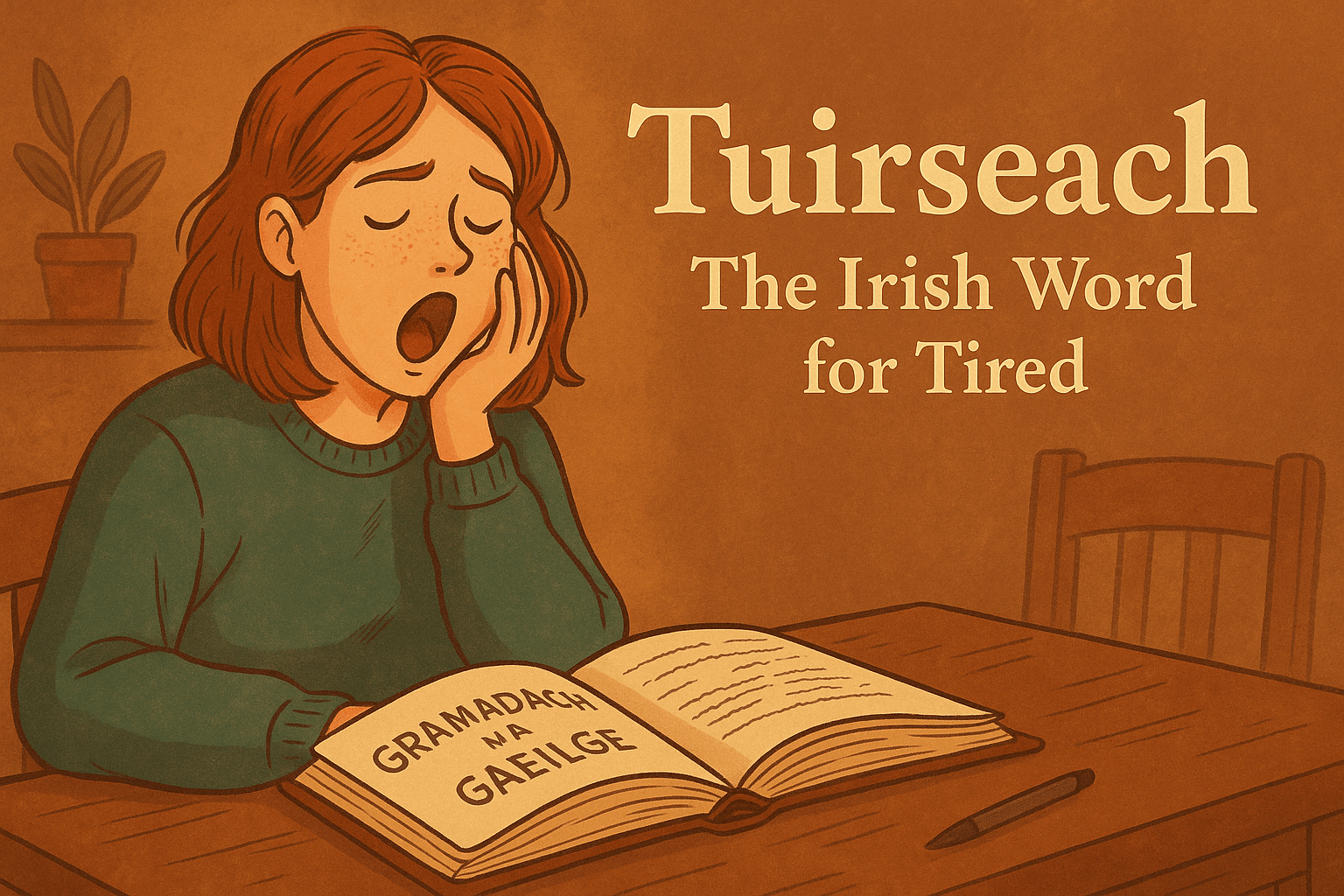Every language has words that capture universal feelings, but few do it with as much depth as Irish. The word “tuirseach” — pronounced tur-shukh or tur-shahk, depending on dialect — means tired, weary, or fatigued. Yet, like many Irish words, tuirseach carries subtle emotional tones that go beyond the literal translation.
In this guide, we’ll explore what tuirseach means, how to use it correctly in sentences, its origins in Irish culture, and how you can learn natural pronunciation and usage with AI-powered Irish learning tools from Gaeilgeoir AI.
The Meaning of Tuirseach
At its simplest, tuirseach means “tired.” You might use it after a long day, a hard walk, or an intense conversation in Irish class!
Examples:
- Tá mé tuirseach. – “I am tired.”
- Bhí siad an-tuirseach tar éis an turais. – “They were very tired after the journey.”
- Ná bí tuirseach de do chuid staidéir! – “Don’t get tired of your studies!”
But tuirseach can also express deeper feelings — emotional exhaustion, weariness, or even being “fed up.” For example:
- Tá mé tuirseach den aimsir seo! – “I’m tired of this weather!”
- Tá sí tuirseach de bheith ag fanacht. – “She’s tired of waiting.”
That’s what makes tuirseach so interesting: it’s not just physical fatigue, but an expression of emotional tiredness and mental strain too — something many learners feel when tackling a challenging new language!
Pronunciation and Dialect Notes
Irish pronunciation changes slightly between dialects (Munster, Connacht, Ulster), but here’s a guide to sounding natural:
| Dialect | Pronunciation | Notes |
|---|---|---|
| Munster | tur-shukh | Soft “kh” sound at the end, like German “Bach.” |
| Connacht | tur-shahk | Slightly lighter ending, common in Galway & Mayo. |
| Ulster | tur-shukh or tur-shak | Tends to have a clipped, energetic tone. |
Listening to native speakers is key. Gaeilgeoir AI’s speech recognition tool helps you perfect your accent and rhythm by giving real-time feedback — so tuirseach rolls off your tongue naturally.
Check out our Irish Pronunciation Guide for detailed help with vowel sounds and regional accents.
Etymology: Where Tuirseach Comes From
Tuirseach comes from the Irish noun “tuirse”, meaning tiredness, weariness, or fatigue. The adjective form (tuirseach) literally means “full of weariness.”
Interestingly, this word is very old, found in early Irish texts describing both physical tiredness and spiritual heaviness. In medieval poetry, tuirseach might describe a weary warrior or a heart tired from love. It reflects the Irish talent for emotional precision — expressing feeling through beautiful simplicity.
How to Use Tuirseach in Context
Because tuirseach can describe both physical and emotional states, it’s useful in many daily Irish expressions. Here are some examples and translations:
| Irish Phrase | English Translation | Context |
|---|---|---|
| Tá mé tuirseach. | I am tired. | The most common form. |
| Tá sé tuirseach traochta. | He’s completely exhausted. | Emphasis with traochta (drained). |
| Tá siad tuirseach den obair. | They’re tired of work. | Emotional fatigue. |
| Bhí sí tuirseach ina dhiaidh sin. | She was tired after that. | Result or consequence. |
| Tá mé tuirseach traochta tar éis an lae. | I’m worn out after the day. | Common Irish phrase. |
In Irish, the word tuirseach often pairs with intensifiers like:
- an- (very) → an-tuirseach = very tired
- go leor (enough) → tuirseach go leor = quite tired
- traochta (exhausted) → tuirseach traochta = utterly tired
These combinations make your Irish more expressive and natural — something Gaeilgeoir AI’s intelligent sentence-builder can help you practice.
Cultural Use: When the Irish Say They’re Tired
In Ireland, tuirseach isn’t always about sleepiness. It’s often used humorously or expressively:
- Tá mé tuirseach de chaint! – “I’m tired of talking!”
- Tá mé tuirseach den pholaitíocht! – “I’m sick of politics!”
The Irish love understatement. Saying “Tá mé tuirseach” might mean “I’m wrecked,” but also “I could use a cuppa.” Understanding tone is key — and that’s where listening practice helps.
With Gaeilgeoir AI’s listening lessons, you can hear native speakers use tuirseach naturally in different contexts — from friendly chats to folk stories.
Common Mistakes with Tuirseach
Even advanced learners can make errors with tuirseach, often due to differences between Irish and English sentence structure.
Here are a few to avoid:
- ❌ Is tuirseach mé.
✅ Tá mé tuirseach.
→ “I am tired” always uses Tá, not Is, because it’s a temporary state. - ❌ Tá mé tuirseach ar obair.
✅ Tá mé tuirseach den obair.
→ In Irish, den (“of the”) expresses “tired of,” not ar (“on”). - ❌ Bhí mé tuirseach go domhain.
✅ Bhí mé tuirseach traochta.
→ Irish prefers traochta (exhausted) rather than “deeply tired.”
Mistakes like these are natural — but AI-powered tools make them easier to correct. Gaeilgeoir AI’s grammar-check and feedback system gives you instant guidance, helping you learn faster and more confidently.
Idioms and Expressions Using Tuirseach
Irish is full of vivid idioms that express fatigue or emotional weariness in creative ways. Learning these adds depth to your speech and writing.
Here are a few related to tuirseach and tiredness:
- Tá mé traochta, tuirseach, agus tuirseach traochta!
→ “I’m worn out, tired, and utterly exhausted!” - Tháinig tuirse orm.
→ “Tiredness came over me.” (A common poetic form.) - Tuirse an tsaoil.
→ “The tiredness of life.” (A beautiful, reflective phrase in literature.)
Exploring idioms is a great way to understand Irish mindset and humor. For more, see our Irish Idioms Language Learning Guide.
Tuirseach in Irish Literature and Song
Irish poetry often uses tuirseach to describe the kind of tiredness that comes from living, loving, or longing — not just lack of sleep.
For example, in early Gaelic verse, warriors were tuirseach den chath — “tired of battle.” In modern songs, lovers might say “Tá mo chroí tuirseach de bheith ag fanacht” (“My heart is tired of waiting”).
This emotional richness shows how flexible the word is. It’s a perfect example of how Irish weaves physical and emotional experience into a single expression.
Learning Words Like Tuirseach with Gaeilgeoir AI
Learning words like tuirseach in isolation isn’t enough — you need to hear, speak, and use them in real context. That’s where AI-powered learning makes a difference.
With Gaeilgeoir AI, you can:
- 🎧 Practice pronunciation with real-time AI feedback.
- 💬 Use words in conversation simulations with native voice patterns.
- 📖 Learn grammar naturally through context-based examples.
- 🌍 Track progress and adapt lessons to your learning style.
Whether you’re just starting out or already conversational, Gaeilgeoir AI helps you sound authentic and confident — without feeling tuirseach from rote memorization!
👉 Try it free today at learn.gaeilgeoir.ai and see how quickly your Irish improves.
The Emotional Side of Tuirseach
There’s something beautifully human about tuirseach. It doesn’t just describe exhaustion — it conveys empathy. Saying Tá mé tuirseach can be a confession of vulnerability, a shared sigh after a long day, or a way to connect with someone who understands that same fatigue.
In many ways, tuirseach reminds us why learning Irish is so rewarding: every word carries emotion, poetry, and history.
When you learn tuirseach, you’re not just learning vocabulary — you’re learning how Irish people express life itself.
Don’t Get Tuirseach — Learn Smart!
The Irish word tuirseach might mean “tired,” but learning it doesn’t have to leave you exhausted. It’s a perfect reminder that every language journey has its ups and downs — and that even tired moments can be full of meaning.
With Gaeilgeoir AI, you can learn naturally, confidently, and joyfully — one word at a time.
So next time you feel tuirseach after studying, smile and say: Ní stopfaidh mé anois! (“I won’t stop now!”)
✨ Start your Irish learning adventure today at learn.gaeilgeoir.ai — and turn your tuirseach into triumph.


